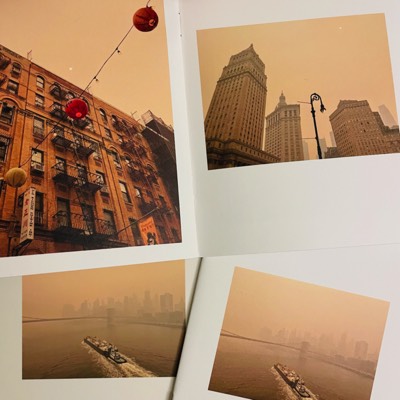On June 7th, 2023, heavy smoke and pollution set into New York City from the wildfires in Canada. I took photos between 2pm and 4pm as I walked from downtown Brooklyn to Chinatown via Manhattan Bridge. I created photo booklets and composed the 28-minute piece above to remember and reflect on my experience.
My decision to work on climate is motivated by emotional acceptance of climate change and the resulting hope/desire to address it. I've always logically accepted climate change, but the emotional acceptance is driven by a) perspectives that describe the nature of its complexity and b) making art that is rooted in understanding my personal experience. Art allows me to approach systems that are too difficult to think about by capturing what their scale feels like – that “so much bigger than me” feeling.
My decision to work on climate is motivated by emotional acceptance of climate change and the resulting hope/desire to address it. I've always logically accepted climate change, but the emotional acceptance is driven by a) perspectives that describe the nature of its complexity and b) making art that is rooted in understanding my personal experience. Art allows me to approach systems that are too difficult to think about by capturing what their scale feels like – that “so much bigger than me” feeling.

Booklet available at Quimby's Bookstore NYC
I first came across the idea of using art (specifically fiction) as a way of approaching complexity in Elvia Wilk’s Death by Landscape, where she introduces Timothy Morton’s hyperobjects. Morton provides a framework for approaching contemporary complexity, they write: “We can only see pieces of hyperobjects at a time”1 as they are “massively distributed in time and space relative to humans.”2 In the insightful essay “The Word Made Flesh,” Wilk explores how Julian of Norwich and other writers approached medieval God through mystical texts, and investigates how new weird fiction today – such as Jeff VanderMeer’s Annihilation – could expand our knowledge of hyperobjects like climate change.3
Area X is a mysterious coastal region in Annihilation that humans are struggling to understand. Wilk describes how the biologist, on an expedition to the area, accidentally inhales spores from living words on a tunnel wall.4 The moment marks the beginning of her “loss of bounded self.”5 Area X affects her physically and psychologically over time – transformation she is acutely aware of.6 Area X sustains its density in the absence of a reductive explanation. Awareness of its magnitude grows as the biologist continues to search for answers by observing and experiencing it.
One of my favorite lines in Hyperobjects is: "You have to wonder whether your poem about global warming is really a hyperobject's way of distributing itself into human ears and libraries."7 Acknowledging the two-way relationship is a key element of emotional acceptance – the relationship continues even if I’m not actively thinking about it.
When I stepped outside on June 7th, I felt I was experiencing a piece of the hyperobject with most of my senses: faint smoky sweet scent as the thick air scratched my throat and made breathing difficult. I wanted to take the opportunity to approach it with my art.
Notes:
1. Morton, Timothy. Hyperobjects: Philosophy and Ecology After the End of the World. University of Minnesota Press, 2013. 70.
2. Morton. Hyperobjects: Philosophy and Ecology After the End of the World. 1.
3. Wilk, Elvia. Death by Landscape. Soft Skull, 2022. 79-81, 91-92.
4. Wilk. Death by Landscape. 74-75.
5. Wilk. Death by Landscape. 92.
6. VanderMeer, Jeff. Annihilation. Southern Reach trilogy. Farrar, Straus and Giroux, 2014. 83.
7. Morton. Hyperobjects: Philosophy and Ecology After the End of the World. 175.
Components of this write-up appear in my essay-collage Why Do I Make Art? Not currently available online.
Area X is a mysterious coastal region in Annihilation that humans are struggling to understand. Wilk describes how the biologist, on an expedition to the area, accidentally inhales spores from living words on a tunnel wall.4 The moment marks the beginning of her “loss of bounded self.”5 Area X affects her physically and psychologically over time – transformation she is acutely aware of.6 Area X sustains its density in the absence of a reductive explanation. Awareness of its magnitude grows as the biologist continues to search for answers by observing and experiencing it.
One of my favorite lines in Hyperobjects is: "You have to wonder whether your poem about global warming is really a hyperobject's way of distributing itself into human ears and libraries."7 Acknowledging the two-way relationship is a key element of emotional acceptance – the relationship continues even if I’m not actively thinking about it.
When I stepped outside on June 7th, I felt I was experiencing a piece of the hyperobject with most of my senses: faint smoky sweet scent as the thick air scratched my throat and made breathing difficult. I wanted to take the opportunity to approach it with my art.
Notes:
1. Morton, Timothy. Hyperobjects: Philosophy and Ecology After the End of the World. University of Minnesota Press, 2013. 70.
2. Morton. Hyperobjects: Philosophy and Ecology After the End of the World. 1.
3. Wilk, Elvia. Death by Landscape. Soft Skull, 2022. 79-81, 91-92.
4. Wilk. Death by Landscape. 74-75.
5. Wilk. Death by Landscape. 92.
6. VanderMeer, Jeff. Annihilation. Southern Reach trilogy. Farrar, Straus and Giroux, 2014. 83.
7. Morton. Hyperobjects: Philosophy and Ecology After the End of the World. 175.
Components of this write-up appear in my essay-collage Why Do I Make Art? Not currently available online.